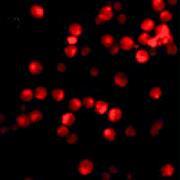A new fluorescent probe that can detect the level of hydrogen peroxide inside living cells has been developed by researchers in China.
A new fluorescent probe that can detect the level of hydrogen peroxide inside living cells has been developed by researchers in China.
A raised level of hydrogen peroxide (H2O2) has been linked with many human diseases, including cancer. The molecule places biological tissues under oxidative stress and can cause significant damage. However, the actual role that hydrogen peroxide plays in disease is unknown, and an accurate way to measure hydrogen peroxide levels in living cells is needed to improve our understanding.

Bo Tang and co-workers at Shandong Normal University, China, have developed a new probe that in contrast to those previously used, shows a highly specific fluorescent response to hydrogen peroxide.
High sensitivity is another feature of the new probe. Nanomolar changes in hydrogen peroxide concentration within the cell can be detected, and levels of H2O2 down to the picomolar range can be identified.
Having demonstrated the potential of his new probe, Tang is now investigating its direct intracellular imaging behaviour to detect oxidative stress in different biological systems.
James R Mitchell Crow
References
K Xu et al., Chem. Commun., 2005, 48, 5974 (DOI: 10.1039/<man>b512440a</man>)






No comments yet